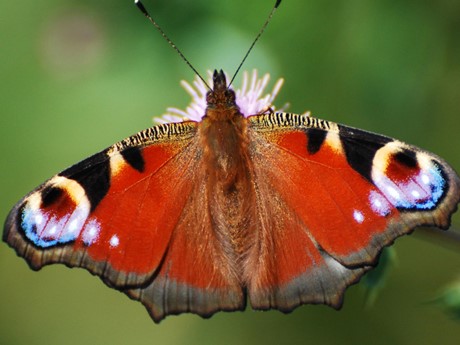Is 2020 a good year for sloes?
Judith Garforth, 07/10/2020
Sloes are the inky-blue fruits of the blackthorn shrub, which can be found bejewelling hedgerows in autumn. They start to ripen between August and October and although they are inedible raw (they’re very astringent), they are a forager’s favourite especially for sloe gin.
This year, I’ve noticed that the hedges in my area are laden with fruit, and we’ve had similar reports from around the UK too. So is it set to be a bumper crop all over the UK for sloes this year?

Sloes are the inky-blue fruits of the blackthorn shrub (Photo: Ben Lee)
What influences the sloe crop?
The abundance of sloes varies from year to year depending on the weather. Sloes develop from blackthorn flowers which bloom early in the year from February to April. So to understand if we’ve had good conditions for sloes this year, it’s necessary to cast our minds back to spring when lockdown had just begun. Can you remember what the weather was like?
Spring weather
Luckily the Met Office provides weather summaries for each month of the year! Although February was quite stormy, overall the blackthorn flowering period was really quite sunny and warm.
- February: 2nd sunniest since 1929, warmer than average.
- March: 9th sunniest since 1929, warmer than average.
- April: sunniest since 1929 and 5th warmest since 1884.

Sloes develop from beautiful blackthorn flowers which bloom early in the year (Photo: Kylie Harrison Mellor)
Pollinators
Blackthorn flowers are pollinated by insects, so they depend on visits from nectar and pollen-collecting insects to set their fruit. Because they flower early in the year, their visitors are insects that active early in the spring such as bumblebees and solitary bees. Warm, sunny weather provides good conditions for pollinating insects that have been hibernating over winter, like queen bumblebees.
The date of first flowering of blackthorn and the date of first sighting of queen red-tailed bumblebees are both recorded for Nature’s Calendar. This spring, the UK average date of blackthorn first flowering was 6 March and the average date of first sighting of a bumble bee was 31 March. So by the time the hedgerows were in full flower, pollinators were also out and about.

Pollinating insects, like the queen red-tailed bumblebee seen here, are needed for pollinating blackthorn flowers as well as many other plants(Photo: Woodland Trust Media Library)
Summer weather
Not only did we have good weather in spring, we also had plenty of rain throughout the summer. The June, July and August rainfall totals were above average. So, there was plenty of water to swell the blackthorn fruit this year too.
A bumper year for sloes?
So the conditions in 2020 have been right, but is it a bumper year for sloes? Well, the ‘amount of blackthorn fruit’ is also something recorded for the Nature’s Calendar project.
We ask our recorders to rate the blackthorn crop each year on a scale from 1 to 5, where 1 represents no fruit and 5 represents an exceptional crop.
1=no fruit, 2=meagre crop, 3=moderate, 4=good crop and 5=exceptional
It’s still early in autumn, and we’ve not got all the records in for 2020 yet, but results so far give an average sloe fruit score of 3.6.
So for 2020, it’s looking like a moderate to good crop based on our data so far. We’ve been collecting records since 2001 and the lowest UK average sloe fruit score was 2.1 in 2008 and the highest was 3.8 in 2011.

You can record blackthorn first flowering, first ripe fruit and amount of fruit, with Nature's Calendar (Photo: Ben Lee)
If you’ve noticed plenty of sloes near you and want to forage for sloe gin, read Helen’s blog for identification tips, responsible foraging guidelines and a good recipe.
Ensure we know how this year’s weather has impacted our wildlife by recording autumn events with Nature’s Calendar. If you’ve seen sloes in your area, add a ‘fruit score’ to the Nature’s Calendar website to help us find out how good the crop is this year, all over the UK. For a little more information and inspiration, take a look at our Autumn video.
